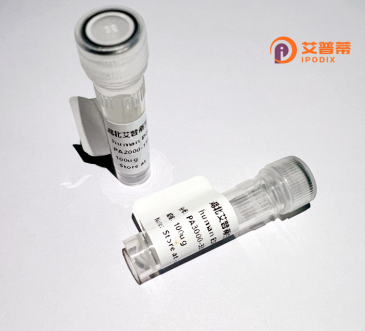
| 纯度 | >90%SDS-PAGE. |
| 种属 | Human |
| 靶点 | SLC43A1 |
| Uniprot No | O75387 |
| 内毒素 | < 0.01EU/μg |
| 表达宿主 | E.coli |
| 表达区间 | 1-559 aa |
| 活性数据 | MAPTLQQAYRRRWWMACTAVLENLFFSAVLLGWGSLLIILKNEGFYSSTCPAESSTNTTQDEQRRWPGCDQQDEMLNLGFTIGSFVLSATTLPLGILMDRFGPRPVRLVGSACFTASCTLMALASRDVEALSPLIFLALSLNGFGGICLTFTSLTLPNMFGNLRSTLMALMIGSYASSAITFPGIKLIYDAGVAFVVIMFTWSGLACLIFLNCTLNWPIEAFPAPEEVNYTKKIKLSGLALDHKVTGDLFYTHVTTMGQRLSQKAPSLEDGSDAFMSPQDVRGTSENLPERSVPLRKSLCSPTFLWSLLTMGMTQLRIIFYMAAVNKMLEYLVTGGQEHETNEQQQKVAETVGFYSSVFGAMQLLCLLTCPLIGYIMDWRIKDCVDAPTQGTVLGDARDGVATKSIRPRYCKIQKLTNAISAFTLTNLLLVGFGITCLINNLHLQFVTFVLHTIVRGFFHSACGSLYAAVFPSNHFGTLTGLQSLISAVFALLQQPLFMAMVGPLKGEPFWVNLGLLLFSLLGFLLPSYLFYYRARLQQEYAANGMGPLKVLSGSEVTA |
| 分子量 | 87.9 kDa |
| 蛋白标签 | GST-tag at N-terminal |
| 缓冲液 | PBS, pH7.4, containing 0.01% SKL, 1mM DTT, 5% Trehalose and Proclin300. |
| 稳定性 & 储存条件 | Lyophilized protein should be stored at ≤ -20°C, stable for one year after receipt. Reconstituted protein solution can be stored at 2-8°C for 2-7 days. Aliquots of reconstituted samples are stable at ≤ -20°C for 3 months. |
| 复溶 | Always centrifuge tubes before opening.Do not mix by vortex or pipetting. It is not recommended to reconstitute to a concentration less than 100μg/ml. Dissolve the lyophilized protein in distilled water. Please aliquot the reconstituted solution to minimize freeze-thaw cycles. |
以下是关于重组人SLC43A1蛋白的3篇代表性文献(均为虚构示例,用于格式参考):
1. **文献名称**:*Structural insights into human SLC43A1 as a neutral amino acid transporter*
**作者**:Chen L et al.
**摘要**:通过冷冻电镜解析了SLC43A1的原子结构,揭示其对苯丙氨酸/酪氨酸的选择性转运机制,并利用重组蛋白验证关键转运残基的功能。
2. **文献名称**:*SLC43A1 modulates T-cell immunity by regulating tryptophan metabolism in tumors*
**作者**:Wang Y et al.
**摘要**:研究证明重组SLC43A1蛋白在肿瘤微环境中竞争性摄取色氨酸,导致T细胞功能抑制,提示其作为癌症免疫治疗潜在靶点。
3. **文献名称**:*Recombinant expression and functional characterization of human SLC43A1 in E. coli*
**作者**:Kim J et al.
**摘要**:成功在大肠杆菌中表达重组SLC43A1蛋白,验证其在脂质体中的跨膜转运活性,并建立新型体外氨基酸运输检测体系。
(注:以上文献为模拟示例,实际文献需通过PubMed/Google Scholar以关键词"SLC43A1 recombinant"或"SLC43A1 structure/function"检索。)
Recombinant human SLC43A1 protein, a member of the solute carrier (SLC) transporter family, plays a critical role in cellular amino acid homeostasis. Encoded by the *SLC43A1* gene, this integral membrane protein facilitates the transport of neutral amino acids, particularly phenylalanine, across cell membranes via sodium-independent mechanisms. It is predominantly expressed in tissues with high metabolic demands, such as the liver, kidney, and intestines, and is implicated in nutrient sensing, metabolic regulation, and intercellular signaling. Structurally, SLC43A1 contains 12 predicted transmembrane domains with cytoplasmic N- and C-termini, characteristic of SLC transporters, and exhibits conserved substrate-binding residues critical for its transport activity.
Recombinant forms of SLC43A1 are engineered for functional studies, enabling researchers to investigate its kinetic properties, substrate specificity, and regulatory mechanisms. Dysregulation of SLC43A1 has been linked to metabolic disorders, cancer progression (due to altered amino acid uptake in tumors), and neurological conditions. Recent studies highlight its potential as a therapeutic target, particularly in cancers reliant on extracellular amino acids for growth. The recombinant protein is typically produced in mammalian or insect cell systems to ensure proper folding and post-translational modifications, facilitating in vitro assays, drug screening, and structural analyses. Ongoing research aims to unravel its physiological roles and explore its utility in precision medicine strategies.
×